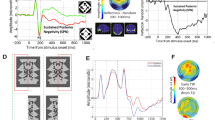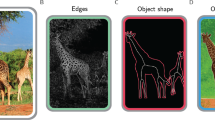Abstract
We assessed how the visual shape preferences of neurons in the inferior temporal cortex of awake, behaving monkeys generalized across three different stimulus transformations. Stimulus-preferences of particular cells among different polygon displays were correlated across reversed contrast polarity or mirror reversal, but not across figure–ground reversal. This corresponds with psychological findings on human shape judgments. Our results imply that neurons in inferior temporal cortex respond to components of visual shape derived only after figure–ground assignment of contours, not to the contours themselves.
This is a preview of subscription content, access via your institution
Access options
Subscribe to this journal
Receive 12 print issues and online access
$209.00 per year
only $17.42 per issue
Buy this article
- Purchase on Springer Link
- Instant access to full article PDF
Prices may be subject to local taxes which are calculated during checkout







Similar content being viewed by others
References
Baylis, G. C., Rolls, E. T. & Leonard, C. M. Functional subdivisions of the temporal lobe neocortex. J. Neurosci. 7, 330–342 (1987).
Desimone, R., Schein, S. J., Moran, J. & Ungerleider, L. G. Contour, color and shape analysis beyond the striate cortex. Vision Res. 24, 441–452 (1985)
DiCarlo, J. J. & Maunsell, J. H. R. Form representation in monkey inferotemporal cortex is virtually unaltered by free viewing. Nat. Neurosci. 3, 814–821 (2000)
Logothetis, N. K., Pauls, J. & Poggio, T. Shape representation in the inferior temporal cortex of monkeys. Curr. Biol. 5, 552–563 (1995).
Riesenhuber, M. & Poggio, T. Nat. Neurosci. 3, 1199–1204 (2000).
Rollenhagen, J. E. & Olson, C. R. Mirror-image confusion in single neurons of the macaque inferotemporal cortex. Science 287, 1506–1508 (2000).
Rolls, E. T., Judge, S. J. & Sanghera, M. K. Activity of neurons in the inferotemporal cortex of the alert monkey. Brain Res. 130, 229–238 (1977).
Sary G., Vogel, R. & Orban, G. Cue-invariant shape selectivity of macaque inferior temporal neurons. Science 260, 995997 (1993).
Tanaka, K. Inferotemporal cortex and object vision. Annu. Rev. Neurosci. 19, 109–139 (1996).
Malach, R. et al. Object-related activity revealed by functional magnetic resonance imaging in human occipital cortex. Proc. Natl. Acad. Sci. USA 92, 8135–8139 (1995).
Farah, M. J. & Aguirre, G. K. Imaging visual recognition: PET and fMRI studies of functional anatomy of human visual recognition. Trends Cogn. Sci. 3, 179–185 (1999).
Farah, M. J. Visual Agnosia (MIT Press, Cambridge, Massachusetts, 1990).
Plaut, D. C. & Farah, M. J. Visual object representation: Interpreting neurophysiological data within a computational framework. J. Cogn. Neurosci. 2, 320–343 (1990)
Rubin, E. Visuell Wahrgenommee Figuren (Gyldendalske Boghandel, Copenhagen, Germany, 1915).
Baylis, G. C. & Driver, J. One-sided edge-assignment in vision: 1. Figure-ground segmentation and attention to objects. Curr. Dir. Psychol. Sci. 4, 140–146 (1995).
Driver, J. & Baylis, G. C. One-sided edge-assignment in vision: 2. Part decomposition, shape description, and attention to objects. Curr. Dir. Psychol. Sci. 4, 201–206 (1995)
Driver, J. & Baylis, G. C. Edge-assignment and figure-ground segmentation in short-term visual matching. Cognit. Psychol. 31, 248–306 (1996)
Baylis, G. C. & Cale, E. The figure has a shape, but the ground does not: Evidence from covert testing of shape recognition. J. Exp. Psychol. Hum. Percept. Perform. 27, 633–643 (2001).
Hoffman, D. D. & Richards, W. A. Parts of recognition. Cognition 18, 65–96 (1984).
Baylis, G. C. & Driver, J. Obligatory edge-assignment in vision: the role of figure and part segmentation in symmetry detection. J. Exp. Psychol. Hum. Percept. Perform. 6, 1323–1342 (1995).
Selzer, B. & Pandya, D. N. Afferent cortical connections and architectonics of the superior temporal sulcus and surrounding cortex in the rhesus monkey. Brain Res. 149, 1–24 (1978)
Pinker, S. Visual cognition: an introduction. Cognition 18, 1–64 (1984).
Rolls, E. T. & Baylis, G. C. Size and contrast have only small effects on the responses to faces of neurons in the cortex of the superior temporal sulcus of the monkey. Exp. Brain. Res. 65, 38–48 (1986).
Biederman, I. Recognition-by-components: a theory of human image understanding. Psychol. Rev. 94, 115–147 (1987).
Nakayama, K., Shimojo, S. & Silverman, G. H. Stereoscopic depth: its relation to image segmentation, grouping, and the recognition of occluded objects. Perception 18, 55–68 (1989).
Palmer, S. & Rock, I. Rethinking perceptual organisation: the role of uniform connectedness. Psychon. Bull. Rev. 1, 29–55 (1994).
Peterson, M. A. Object recognition processes can and do operate before figure-ground organisation. Curr. Dir. Psychol. Sci. 3, 105–111 (1994).
Robinson D. A. A method of measuring eye-movements using a scleral search coil in a magnetic field. IEEE Trans. Biomed. Eng. 101, 131–145 (1963).
Baylis, G. C., Rolls, E. T. & Leonard, C. M. Selectivity between faces in the responses of a population of neurons in the cortex of the superior temporal sulcus of the monkey. Brain Res. 342, 91–102 (1985).
Acknowledgements
G.C.B. was supported by grants from the National Institutes of Health (R29 NS27296) and the National Science Foundation (SBR 96-16555). J.D. was supported by the Biotechnology and Biological Sciences Research Council (UK).
Author information
Authors and Affiliations
Corresponding authors
Rights and permissions
About this article
Cite this article
Baylis, G., Driver, J. Shape-coding in IT cells generalizes over contrast and mirror reversal, but not figure-ground reversal. Nat Neurosci 4, 937–942 (2001). https://doi.org/10.1038/nn0901-937
Issue Date:
DOI: https://doi.org/10.1038/nn0901-937
This article is cited by
-
The inferior temporal cortex is a potential cortical precursor of orthographic processing in untrained monkeys
Nature Communications (2020)
-
Beyond Simple and Complex Neurons: Towards Intermediate-level Representations of Shapes and Objects
KI - Künstliche Intelligenz (2015)
-
Globally consistent depth sorting of overlapping 2D surfaces in a model using local recurrent interactions
Biological Cybernetics (2008)
-
The neural mechanisms of perceptual filling-in
Nature Reviews Neuroscience (2006)
-
Visual competition
Nature Reviews Neuroscience (2002)



